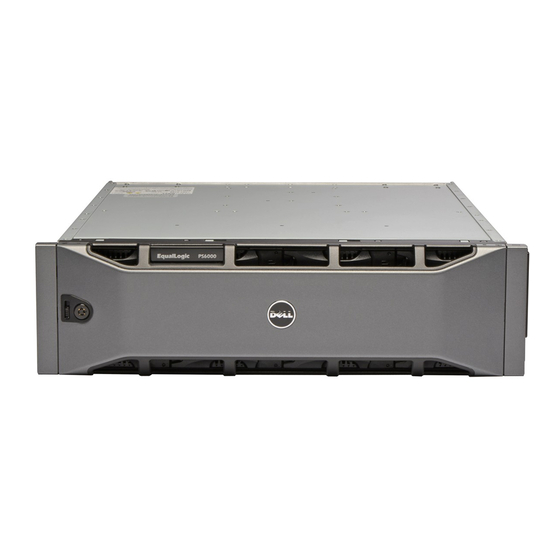Dell EqualLogic PS6100X 하드웨어 매뉴얼 - 페이지 40
{카테고리_이름} Dell EqualLogic PS6100X에 대한 하드웨어 매뉴얼을 온라인으로 검색하거나 PDF를 다운로드하세요. Dell EqualLogic PS6100X 50 페이지. Equallogic ps series storage products
Dell EqualLogic PS6100X에 대해서도 마찬가지입니다: 개요 (7 페이지)

Replication
Replication enables you to copy volume data across groups, physically located in the same building or separated by
some distance. Replication protects the data from failures ranging from destruction of a volume to a complete site
disaster, with no impact on data availability or performance. Similar to a snapshot, a replica represents the contents of a
volume at a specific point in time. There must be adequate network bandwidth and full IP routing between the groups.
The volume is located in the primary group and the volume replicas are stored in the secondary group, in the space that
is delegated to the primary group. Mutual authentication provides security between the groups. The first replica of a
volume is a complete transfer of the volume data from the primary group to the secondary group over the network. For
subsequent replicas, only the data that changed since the previous replica is transferred to the secondary group. If you
need to transfer a large amount of volume data for the first replication, you can use manual transfer replication.
This enables you to copy the volume data to external media and then load the data from the media to the replica set on
the secondary group. After the first data transfer is complete, replication continues, as usual, over the network.
NOTE: To copy the data remotely when you are setting up replication, use the manual transfer utility.
Replicating Volumes
To replicate a volume from one group to another:
1.
Configure two groups as replication partners:
a) Log in to each group.
b) Configure the other group as a replication partner, and delegate space to the partner.
c) For each group, specify the partner's name, partner's group IP address, and reciprocal passwords for mutual
authentication.
2.
Configure replication on the volume:
a) Log in to the primary group and configure replication on the volume.
b) Specify the following information for each volume:
*
Partner that stores the replicas (secondary group).
*
Replica reserve size on the secondary group.
*
Local replication reserve size on the primary group and whether to enable the borrow free space
option.
*
Whether the first replication occurs over the network or by using manual transfer replication.
*
Whether to keep the failback snapshot. You require more local replication reserve if you keep the
failback snapshot.
3.
Start the replication:
Either create a replica or set up a schedule to create replicas on a regular basis.
4.
Check that the replication completes:
Periodically check the replication space utilization and make modifications as needed.
To recover volume data from replicas in the secondary group, you can clone an individual replica to create a new
volume. You can also use failback functionality to temporarily host a volume from the secondary group for backup
purposes or if the primary group is unavailable due to failure or maintenance. Later, you can failback to the primary
group and return to the original replication configuration, in some cases, by replicating only the volume changes
that occurred while the volume was hosted on the secondary group. You can also use failback functionality to
permanently switch partner roles.
40
